#Emperor Heraclius
Photo

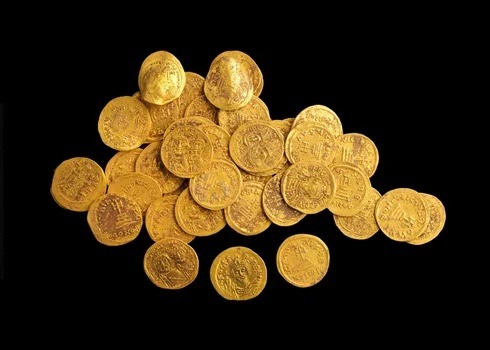
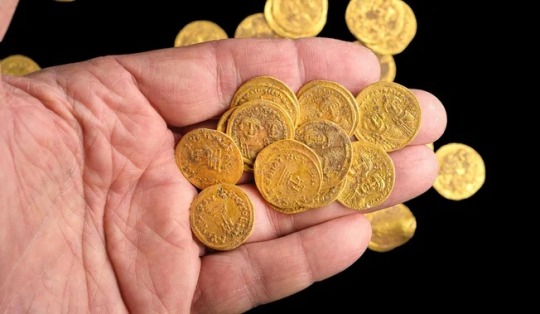


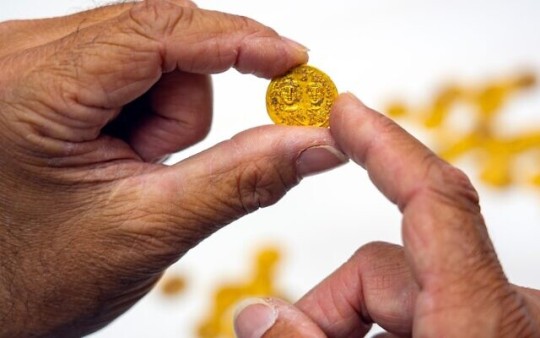



An Ancient Hoard of 44 Byzantine Gold Coins Discovered in Israel
A hidden cache of 44 gold coins dating from the Muslim conquest of Jerusalem was recently found during an archaeological excavation at the site of the ancient city of Banias, the Israel Antiquities Authority (IAA) revealed on Monday.
Several of the coins were dated to the reigns of Emperor Phocas (602–610) and Emperor Heraclius (610-641), the latter of which overlapped with the Muslim conquest of Byzantine Palestine in 635.
“The coin hoard, weighing about 170 grams … reflects a specific moment in time, when we can imagine the owner concealing his fortune in the threat of war, hoping to return one day to retrieve his property. In retrospect, we know that he was less fortunate,” said Yoav Lerer, who directed the excavation on behalf of the IAA.
Banias, which is located within the Hermon River nature reserve, was first established by Canaanites and reached its peak in the Early Roman period, when Herod the Great and his son Philip II entirely rebuilt the city and named it Caesarea Philippi, in honor of Roman Emperor Augustus.
According to Christian tradition, Banias is where Peter the Apostle recognized Jesus as the messiah and thereafter received the keys to the kingdom of heaven, as recounted in Matthew 16:18.
Eli Escusido, director of the Israel Antiquities Authority, said of the discovery: “The coin hoard is an extremely significant archaeological find as it dates to an important transitional period in the history of the city of Banias and the entire region of the Levant. The Israel Antiquities Authority, together with the National Parks Authority, will work together to exhibit the treasure to the public.
#A Ancient Hoard of 44 Byzantine Gold Coins Discovered in Israel#coins#collectable coins#gold coins#ancient coins#ancient artifacts#archeology#archeolgst#history#history news#ancient history#ancient culture#ancient civilizations#emperor phocas#emperor heraclius#emperor augustus#banias
218 notes
·
View notes
Photo
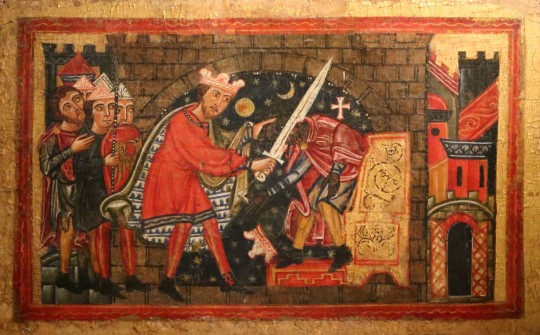
Master of Tressa - Heraclius beheading Chosroes. 1215
47 notes
·
View notes
Text

Finally covered the gap between the fall of the west and Michael III :D
#byzantine empire#byzantine emperor#byzantine empress#byzantium#pride#gay#history art#digital art#5th century#6th century#7th century#8th century#9th century#roman tag#greek tag#justinian the great#emperor heraclius
10 notes
·
View notes
Text

Emperor Heraclius Slays the King of Persia
#emperor heraclius#slays#king#persia#art#knights#medieval#middle ages#gothic#armour#byzantine#chivalric romance#chivalry#history#painting#heraclius#chosroes#emperor#constantinople#byzantium#europe#european#combat#arms#jerusalem#asia minor#byzantines#persians#holy cross#true cross
29 notes
·
View notes
Text

I love making these hdgdjdhjf
#justinian ii#leo i#constantine v kopronymos#leo v the armenian#emperor theophilos#emperor zeno#constantine vi#emperor maurice#emperor heraclius#byzantine things#homegrown memes
9 notes
·
View notes
Text
Secrets of the Hagia Sophia - Healing Powers, Mysterious Mosaics and Holy Relics | Ancient Origins
https://www.ancient-origins.net/ancient-places-asia/hagia-sophia-istanbul-secrets-god-003133
View On WordPress
#1200#1264#Apollonius of Tyana#Ayasofa#Basilica#Blue Mosque#Byzantine#Constantinople#Deesis Mosaic#Divine Wisdom#Eastern Orthodox Church#Emperor Door#Emperor Heraclius#Emperor Justinian I#Fourth Crusade#Hagia Sophia#Istanbul#Jesus#mosque#Mustafa Kemal Ataturk#Nails#Noah&039;s Ark#relics#Sancta Sophia#Seraphim#Shroud#St. Gregory the Miracle Worker#Sultan Ahmed Mosque#Sultan Mehmed III#Virgin Mary
0 notes
Text
Anastasios I of Byzantium had heterochromia like some kind of teenage OC, but regrettably it was wasted on him because he was among the most boring emperors ever. his hobby was fiddling with tax policy and accidentally causing riots by adding five words to a church song. they should have given that shit to Heraclius
5K notes
·
View notes
Photo

History Births on July 07
0 notes
Note
How did all the heresies and theological arguments of the Late Roman Empire lead to "the Arab caliphates getting a decent navy and winning the Battle of the Masts"?
This is actually a fascinating story about the nature of the religious world and religious politics in the Late Roman and Byzantine Empires and the Rashidun Caliphate.
Because heresies and theological arguments tended to start at the level of bishops and patriarchs fighting with the bishops and patriarchs of other metropoles (and that filters out to which missionaries were sent where), there were strong regional variations as to which position was in the local majority.
Skipping over the Arian controversy because it's not relevant to the Battle of the Masts, Cyril of Alexandria was the leader of the Monophysite faction ("physis" meaning "nature," i.e Christ has one nature, which tracks with the Council of Nicaea's declaration that he had one "essence"), and his dyophysite (meaning two "natures") rivals were based out of Antioch - and Alexandria and thus Egypt became Monophysite. However, Constantinople and Anatolia were dyophysite and worked to make sure that the Second Council of Ephesus and the Council of Chalcedon declared monophysitism a heresy and dyophysitism as Orthodoxy, thus leading to the Chalcedonian Schism.

Following on from this, the emperors Justin II and Justinian I were Orthodox. Now, Justinian tried to end the Schism through the Second Council of Constantinople in 553, but this didn't really work and it remained state policy to persecute Monophysites. However, the empress Theodora was Monophysite and acted as patroness and political defender of Monophysites throughout the empire - which made her very popular in Egypt...and with the Greens in the Hippodrome, who were also Monophysites. Naturally, if the Greens were Monophysite, the Blues were Orthodox, because why not turn your sports rivalry into a religious rivalry and a pseudo-political party system? It's not called the Byzantine Empire because it's simple.
Even though Theodora was a Green, Justinian supported the Blues, which meant that no matter what your sports team or religious views or pseudo-partisanship you could support the imperial family. (Indeed, many historians think that the two at least somewhat arranged their religious and sports affiliations with this in mind.) This worked...up until the Nika riots ended up with Belisarius turning the Imperial army on the sports fans turned revolutionary rioters in the Hippodrome, leading to the deaths of as many as 30,000 people.
And so it went, with Alexandria tending to be the losers in the monoergism vs. dyoergism (does Christ have one "energy" or two?) debate, and the monolethitism vs. dyolethetism (does Christ have one "will" or two?) debate. Notably, these debates saw the Emperors of the time trying to get the Church to adopt a compromise (both monoergism and monothelitism were essentially an attempt by the Emperor Heraclius and his Patriarch to find a new theological formulation that the Alexandrians could live with while pointing urgently in the direction of first the Persians and then the Arabs) and failing due to religious partisans digging in their heels, or Emperors siding violently with one side or the other, ironically in the name of Imperial unity.
And this brings us to the Arab Conquest that gave birth to the Rashidun Caliphate. Now, the Christian population of Alexandria was not exactly thrilled about suddenly being ruled over by Muslim Arabs in 642...but in a genius stroke of enlightened self-interest, the Rashidun Caliphate adopted a policy whereby non-Muslim subjects (dhimmis) would be left alone in terms of religious matters as long as they paid their jizya taxes on non-Muslims (with the idea being to create a financial incentive to convert). While this wasn't the most popular, the Alexandrians realized that having to pay religious taxes and then getting left alone in peace and quiet to be Monophysite was a much better deal than having to pay Byzantine imperial taxes and getting religiously persecuted all the damn time.
This mattered geostrategically, because the Port of Alexandria was one of the largest ports in the Mediterranean, and thus had one of the largest shipyards and a lot of shipbuilders, and a hell of a lot of trained ex-Roman sailors and marines who were heavily Monophysite. These recently-unemployed sailors and marines were very happy to work for the Rashidun Caliphate, especially when the Caliphs started to shift resources into the navy to combat Byzantine dominance on the seas. Thus, only a few years after the Rashidun conquest of Egypt in 642, the Arab navy was suddenly able to fight on equal terms with the Byzantine navy - and then started kicking their ass.

This at last brings us to the Battle of the Masts in 655, where an Arab fleet (crewed mostly by Monophysite Egyptians) of 200 ships under the command of admiral Abu al-A'war came into contact with a Byzantine fleet of 500 ships led by the Emperor Constans II off the coast of Lycia...and smashed it to pieces. According to the historian al-Tabari, it was called the Battle of the Masts because there were rough seas and both fleets lashed themselves together to allow for marine boarding operations, so that soldiers were literally crossing from mast to mast. Constans II supposedly only managed to escape by changing uniforms with one of his subordinates as a disguise.
The defeat was so crippling that Constantinople was brought under siege for the first time by the Rashidun that same year, although that brief siege (the brevity of which is why historians refer to the siege of 674-678 as the "First Arab Siege of Constantinople") was unsuccessful due to a storm that sunk the Arab ships carrying the artillery and siege engines that the land army was counting on. Naturally, the Byzantines attributed this storm and the first Arab civil war that broke out in 655 (which bought the Byzantines some desperately-needed breathing room) to divine intervention.
Just to show how the past is always with us, I wanted to share a bit of a statement by the Coptic Orthodox Church of the Southern United States:
"The Coptic Orthodox Church was accused of being 'Monophysite' in the Council of Chalcedon. The term monophysite comes from two Greek words meaning "single nature". Monophysitism merged Christ's humanity into His divinity so that effectively it meant that in Christ there was only one single nature, a divine nature. This is NOT what the Coptic Orthodox believes. We believe that "Christ's divinity parted not from His humanity, not for a single moment nor a twinkling of an eye" and we recite this statement in every liturgy. As a result, we are Miaphysite and not Monophysite. Miaphysitism (one nature) means the Lord Jesus Christ is perfect human and perfect divine and these two natures are united together without mingling, nor confusion, nor alteration in one nature; the nature of God incarnate."
43 notes
·
View notes
Text

The Exaltation of the Holy Cross
The Emperor Heraclius recovered the cross in 614 from Persians, intending to carry the cross to Jerusalem himself, but was unable to move forward until he took off his imperial garb & became a barefoot pilgrim.
Prints, plaques & holy cards available for purchase here: (website)
86 notes
·
View notes
Photo

Map of Eastern Roman Empire in 641 after the death of Emperor Heraclius.
89 notes
·
View notes
Text
According to some ḥadīth reports, Muhammad was born without a foreskin, while others maintain that his grandfather, ʿAbd al-Muṭṭalib, circumcised him when he was seven days old. Some ḥadīth report that Heraclius, Emperor of the Byzantine Empire, had referred to Muhammad as "the king of the circumcised".
20 notes
·
View notes
Photo
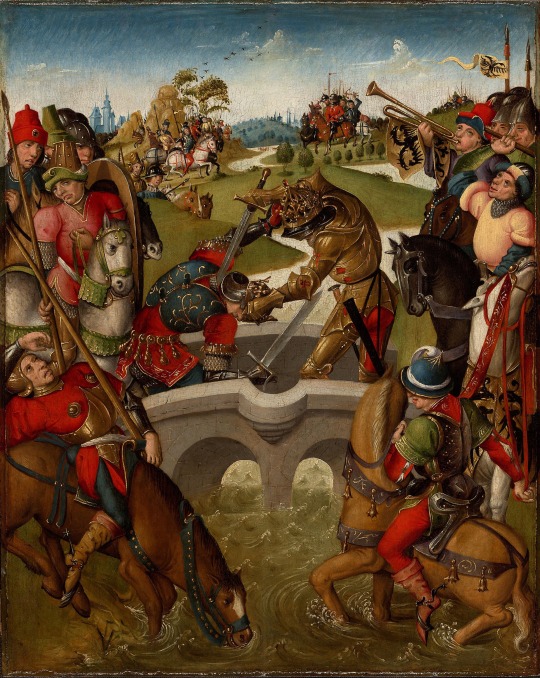
Unknown Artist - Emperor Heraclius Slays the King of Persia. 1485 - 1495
#art#renaissance#unknown artist#figh#fighting#emperor heraclius#king#king of persia#horsrider#rider#horseman
50 notes
·
View notes
Text

5th Saturday of Great Lent: of the Akathist to the Theotokos
Commemorated on April 20
When the archangel understood the mysterious command, he came to the house of Joseph with haste and proclaimed to the unwedded Lady: The One Who bowed the heavens by His condescension is contained wholly and without change in you! As I behold Him in your womb, taking the form of a servant, I am frightened, but cry: Rejoice, unwedded Bride!
On the Fifth Saturday of Great Lent, the Saturday of the Akathist, we commemorate the “Laudation of the Virgin” Icon of the Most Holy Theotokos.
In 625, when the emperor Heraclius was fighting the Persians, the Khan sent forces to attack Constantinople by land and by sea. Patriarch Sergius urged the people not to lose heart, but to trust in God.
A procession was made around the city with the Cross of the Lord, the robe of the Virgin, the Icon of the Savior not made by hands, and the Hodēgḗtria Icon of the Mother of God. The Patriarch dipped the Virgin’s robe in the sea, and the city’s defenders beat back the Khan’s sea forces. The sea became very rough, and many boats sank. The invaders retreated, and the people of Constantinople gave thanks to God and to His Most Pure Mother.
On two other occasions, in 655 and 705, the Theotokos protected the city from Saracen invaders. A feastday dedicated to the Laudation of the Virgin was established to commemorate these victories. The Akathist to the Mother of God is believed to originate from this period, and its use has spread from Constantinople to other Orthodox lands.
The icon before which the Akathist was sung was given to the Dionysiou Monastery on Mt. Athos by Emperor Alexius Comnenos. There, it began to flow with myrrh. There were at least three wonderworking copies of this icon in Russia before the Revolution.
This icon shows the Mother of God seated on a throne, and surrounded by Prophets with scrolls.
[Text from OCA]
Victorious leader of triumphant hosts, we your servants, delivered from evil, sing our grateful thanks to you, Theotokos! As you possess invincible might set us free from every calamity, so that we may sing: Rejoice, unwedded Bride!
13 notes
·
View notes
Text
A Thing Of Vikings Chapter 71: Next To Godliness
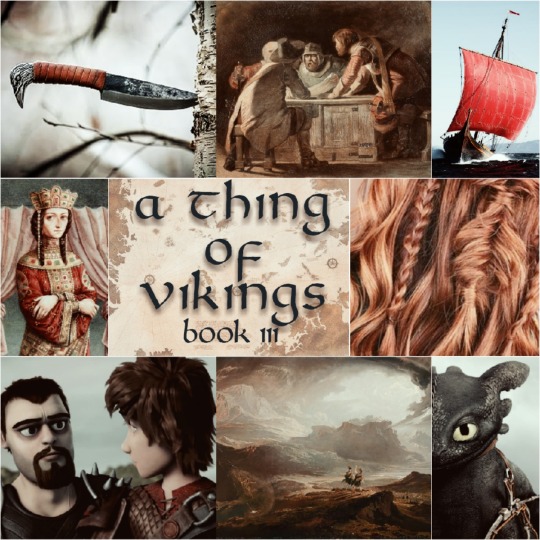
Chapter 71: Next To Godliness
In the aftermath of the collapse of the Western Roman Empire, the Byzantine Roman Empire had inherited the full formalized legal and political structure of the old Roman Empire itself, without needing to reinvent it. This structure gave it the internal cohesion it needed to maintain its political and military strength. As part of that political strength, the Empire was noted for playing its various rivals and neighbors off against one another in order to keep threats at bay.
One of the core aspects of Byzantine military policy was their use of diplomacy and foreign influence in the furtherance of military strategy. They maintained active ambassadors with every neighboring state and many that were further away, and did not hesitate to meddle in the internal affairs of other states.
This made the Byzantine Bureau of Barbarians (Greek: Skrinion tōn Barbarōn) an office of considerable influence and importance in the intricate bureaucratic and political structures of the Byzantine government, and it did its job masterfully. Suspected of having been the espionage office of the Empire by modern scholars, it was, officially, a protocol office for dealing with the ways of foreigners. However, the office also maintained lists of rivals to foreign thrones, and would happily supply those individuals with money and support if it looked as if the current throne-holder might become a threat, or possibly merely uncooperative.
The Empire also made use of a similar tactic on a larger scale—supporting rival states if their neighbors threatened the Empire. If the Rus' threatened war, then the Pechenegs could be subsidized. If the Bulgarians grew restive, then the Rus' could be contacted and favors called in. A noted exemplar of such divide-and-conquer tactics was Emperor Heraclius, who once intercepted a note from the Persian king ordering the execution of a general and his staff. The emperor added 400 names to the execution list and sent the note on its way, and watched as the Persian empire fought itself to put down the rebellion that ensued.
Another example of such manipulation occurred when it came to light that Sigurd Trondsson (see Chapter 21: The Dragon Riders) was actually Snotlout clan Jorgenson, effectively next in line to inherit the chiefdom of Berk after Hiccup clan Haddock and his issue. The Bureau…
—Constantinople: The Child of Rome's Empire, Venice, Italy, 1725
AO3 Chapter Link
~~~
My Original Fiction | Original Fiction Patreon
12 notes
·
View notes
Text
Buried treasure of 44 Byzantine gold coins found in nature reserve in Israel

Excavators in Israel have discovered a trove of 44 Byzantine gold coins and other valuables.
Coins from the hoard were minted by the Byzantine Empire during the reign of Emperor Phocas (A.D. 602 to 610) and Emperor Heraclius (A.D. 610 to 641). All of the pieces of money were gold solidus coins, which were common currency during the Byzantine era (circa A.D. 330 to 1453). Experts from the Israel Antiquities Authority (IAA) dated the latest coins in the cache to the time of the Muslim conquest of Byzantine Palestine, which occurred in A.D. 635, according to a statement.
"Most of the coins are of the Byzantine Emperor Heraclius," Gabriela Bijovsky, a numismatic expert with the IAA, said in the statement. "And what is particularly interesting is that in his early years as emperor, only his portrait was depicted on the coin, whereas after a short time, the images of his sons also appear. One can actually follow his sons growing up — from childhood until their image appears the same size as their father, who is depicted with a long beard." Read more.
218 notes
·
View notes